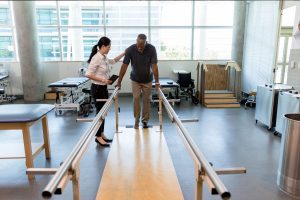Guest Blog: The Importance of Early Rehabilitation for Injury Recovery
If you’ve ever been injured, you know how hard it can be to get back to your normal routine. You want to make sure that your injury heals properly, but you also need to stay active in order to rebuild strength and mobility. That’s why it’s so important to start early rehabilitation as soon as possible after an injury occurs—even if it means taking a few days off from work or training until the initial pain subsides.
Early Rehabilitation is the key to a successful recovery from injury
Early Rehabilitation is the key to a successful recovery from injury.
Early intervention is essential to ensure an optimal outcome following trauma or surgery, and can help you return to your previous level of function with minimal risk of developing chronic pain. Early rehabilitation helps reduce your risk of developing chronic pain and restores normal movement patterns, joint integrity and strength. Afterwards proteins must be consumed in your diet as it helps in many ways to cure injury.
Recovery from an injury doesn’t have to be stressful or frustrating.
Recovery from an injury doesn’t have to be stressful or frustrating. In fact, rehab can be a fun and rewarding experience if you’re willing to listen to your body and work with it as much as possible.
In the weeks following surgery or an acute injury, there are several things you can do to prepare yourself for the road ahead. It’s important that you don’t rush into activity–if anything hurts even slightly, take a break! Listen closely when doing any kind of physical activity; if there is any pain or discomfort at all (even slight), stop immediately and rest until the next day before trying again.
This may seem counterintuitive at first but allowing yourself plenty of time between sessions will allow tissues in need of healing time for proper recovery and repair without causing further damage by rushing through exercises too quickly or ignoring warning signs from your body telling you something isn’t quite right yet. For injuries with major marks scar treatment should be provided.
The longer you wait before starting your rehabilitation, the harder it will be to recover.
The longer you wait before starting your rehabilitation, the harder it will be to recover. The longer you wait, the more your body will change. Your muscles will atrophy and become weaker over time if they’re not being used regularly; if you have an injury that prevents physical activity (as many do), this can cause serious problems down the road.
The longer we delay getting back into our daily routines after an injury or surgery, the harder it gets for us to regain strength and range of motion in our joints as well as regain confidence in using them again–which means that even after rehabilitating ourselves properly once we start, we may still find ourselves struggling with mobility issues later on down the line!
Early intervention is key to a speedy recovery.
The earlier you begin rehabilitation, the better. In fact, research has shown that early intervention can help you return to your previous level of function and reduce your risk of developing chronic pain. Early intervention also helps restore normal movement patterns and joint integrity by focusing on gentle exercise that encourages movement without causing pain or further injury.
Early rehab is also a good way to prevent injuries in the first place: if you’re not working out after an injury or surgery, it’s easy for other parts of your body (like muscles) to weaken while they’re resting–and this can make them more susceptible to getting hurt again later on down the road.
Early rehabilitation can help you return to your previous level of function.
You may think that rehabilitation is a quick and easy fix. Unfortunately, it’s not.
Rehabilitation is a process that takes time and involves many steps. The goal is not to make you feel better or stronger in the short term; rather, it’s about helping you return to your previous level of function and independence as soon as possible so that you can resume normal activities without pain or limitations on your ability to do things like walk up stairs or pick up objects from the ground.
The best way for this process to work effectively? Start early!
Early rehab helps reduce your risk of developing chronic pain.
Early rehabilitation can help you recover from an injury faster and reduce the risk of developing chronic pain.
Early rehabilitation is important because it helps prevent chronic pain, which is often a result of inactivity and immobility after an injury. When you’re injured and can’t move, your muscles start to weaken over time. Without regular exercise or movement, these weakened muscles become even weaker–and more likely to cause injuries down the road as they try to carry out tasks that are too much for them! This process is known as muscle atrophy (loss of size) or weakness due to disuse atrophy (loss). In other words: if you don’t use it now…you might not be able to use it later on!
Another reason why early rehab matters so much? It may help keep surgery at bay! Studies have shown that people who participate in physical therapy following their injury have fewer surgeries than those who do not receive therapy services.* In addition, those who receive early intervention tend not only experience less pain but also return back into work sooner than those who do not receive any kind of treatment whatsoever.*
Early rehab helps you restore normal movement patterns and joint integrity.
The first step in the rehabilitation process is to restore normal movement patterns and joint integrity. When an injury occurs, there are often changes in the way you move, including muscle weakness and loss of mobility. Your physical therapist will help you regain these abilities by guiding you through a variety of exercises that focus on specific muscles and joints.
The goal of early rehab is to get you back to your previous level of activity as soon as possible while reducing the risk of further injury or pain caused by continued use without proper treatment (known as overuse).
It’s important to work with a doctor and physical therapist who understand the needs of athletes, and can help you stay on track with your recovery.
It’s important to work with a doctor and physical therapist who understand the needs of athletes, and can help you stay on track with your recovery. You also need to stay motivated and positive.
If your injury is severe enough to require surgery, there are some things that can be done in the early stages of rehabilitation before surgery:
- Prehabilitation exercises – these are exercises that help prepare muscles for activity after surgery or an injury (e.g., stretching)
- Postoperative care instructions from doctors or physical therapists
Conclusion
We hope this article has helped you understand the importance of early rehabilitation, and how it can help you recover from injury. The longer you wait before starting your recovery plan, the harder it will be to get back to normal. It’s important to work with a doctor and physical therapist who understand the needs of athletes, so they can keep track of your progress throughout treatment.
3 Hidden Signs of Mobility Problems
While you don’t have to be overly observant to recognize that difficulty walking can spell trouble for your mobility, you may not necessarily be on the lookout for less subtle signs that can serve as red flags too. Check out this quick list of three hidden signs of mobility problems:
Avoiding Stairs
Are you opting to take the elevator more than normal? How about spending more time on the ground floor of your home to avoid using a staircase? Stairs can be one of the most difficult environments to traverse when mobility problems are starting to set in.
Stairs require extra leg strength, coordination, and balance. Avoiding stairs, whether conscious of it or not, could be a red flag. Same goes for exercise. If you are finding excuses to skip regular exercise because of mounting difficulties with getting around, it’s time to seek assistance.
Frequent Falling
While falls aren’t all that uncommon for seniors (one out of four seniors experiences a fall every year), frequent falling could indicate mobility difficulties. Even if you have not yet experienced an injury due to a fall, the fact that you fall even more than once a year could shed light on underlying risk factors negatively impacting your mobility including motor impairment and balance problems.
Chronic Illness
You may think that only chronic illnesses which directly affect your leg strength and coordination would impair your mobility, like Parkinson’s or multiple sclerosis, however, you would be wrong. Conditions including diabetes, arthritis, and even heart disease can play a role in reducing your ability to quickly and safely move with ease.
Heart failure, for example, can leave your short of breath when you walk or stand for long periods of time. Diabetes can affect nerves in the legs and feet and arthritic joint inflammation can make walking painful.
Researchers have found less common risk factors that also increase an older adult’s chances of developing mobility problems. These include drinking or smoking, recent hospitalization, having symptoms of depression and experiencing memory and critical thinking problems.
Mobility difficulties do not need to be the end of the line for you. Advancements in technology, design, and engineering have revolutionized the assistive devices people with mobility problems can use. Utilizing equipment to help keep you mobile like motorized scooters, walkers, canes, and specialty wheelchairs can play an important role in both your health as well as your outlook on life.
Guest Blog: Adult day programs giving a new life to the adults
Those who had enjoyed a considerable amount of independence in their youth, the time has come when they need help from others as they were migrated to old age. Life is never static, and it keeps on changing from time to time because change is the integral and inherent part of life. Once you cross the fancy days of your youth and step into adulthood, life becomes more challenging than ever. It took a big leap when you get older and started calling by the people as elderly.
The adult day care homes came up as a hope for many adults who are living a lonely and concise life. They have given them many reasons to enjoy their adulthood, keeping aside all their worries and tensions of life. Many daycare homes in the USA have gone to the extent of providing a friendly and composite environment that even doesn’t get in their homes. The adult day programs in Atlanta offer a welcoming environment to the adults by connecting them back to mainstream society and expanding their outreach. They provide support and a needed break for someone who cares for a loved one who is no longer independent.
Every adult is welcomed in an adult day care home.
The adult day care homes take care of every adult regardless of their religion, race, and ethnicity. Caregivers in the Atlanta adult day care homes are not the ordinary people infect they are the one who is not doing this just as a job but it’s is their passion and nature to help elders and share their pain and joy. All the adults staying in the adult day care homes spent their day with loads of fun and doing meaningful activities.
It is not that adult daycare homes only provide emotional or medical support to the adults; they also facilitate adults by organizing musical events and taking them to cultural festivals. Some of them hold weekly performances by local musicians and local entertainers. They also give them the opportunity for interactions with pets and children, cooking projects, take them to nature walks, games, parties, and yoga classes.
Who joins adult day care homes?
- Adults in their 50s – 90s with some physical or cognitive behavioral problems.
- Older adults who don’t wish to stay home alone all through the day.
- Older adults can benefit from social interaction and a structured environment.
- Adults who are abandoned by their family and they are forced to live alone.
- Adults whose children are not living with them because either for work or study, they have to live outside the town or country.
Loads of Surprises
It is not that the adults living in the Adult Daycare homes are entirely cut off from their families and friends. This is not the case with every adult day care home because many Adult daycare homes provide surprise adults’ by suddenly calling their family members and close friends for a quick meet up or gathering.
As much as adults miss their family members, their family members also miss them equivalently.
Learn and earn schemes
Money adult Daycare homes also provide learning and earn schemes to the adults who want to do something big in their life. It doesn’t mean that if you are elder or older, your professional life is over. Many adults are still willing to work after their retirement from their professional life. The adult Daycare homes provide equal opportunities for adults.



